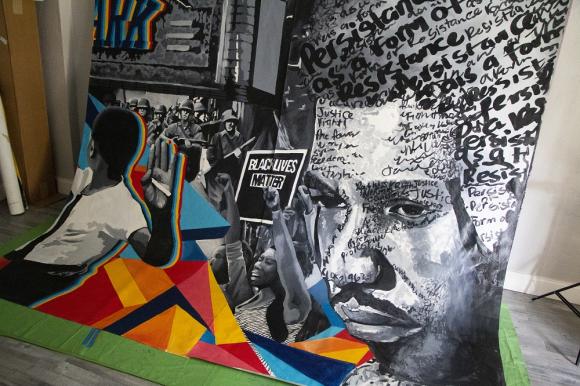
This Fall marks the 50th Anniversary of the Rutgers Law School’s Clinical Legal Education Program. While the onset of COVID -19 restrictions has necessitated the postponement of a planned national clinical conference and alumni gala around this milestone on the theme of “Persistence as a Form of Resistance,” the law school has gone ahead with plans for a mural by local, social justice urban artist, Yasmin Dejesus to commemorate that history.
The mural will adorn the walls of the entryway to the law school’s clinical suite, now known as the “Frank and Marilyn Askin Wing” –named after the dynamic founder of Rutgers’ first in-house clinic and longtime champion of the program, Professor Emeritus Frank Askin, and his wife, Marilyn, an adjunct professor in elder law at the law school.
The mural depicts the social circumstances animating the clinic’s origins in the late 1960’s. Black law students issued an indictment of the law school’s curriculum and shut down the school for a day over the lack of socially relevant and practically meaningful educational opportunities at the law school as urban New Jersey still simmered from the Newark rebellion of 1967.
The mural references the police abuse of cab driver John Smith that touched off days of unrest in the streets in 1967, and the iconic image of a small child with hands raised as followed by armed national guard through Newark’s streets. It includes reference to Dr. Martin Luther King, Jr.’s visit to Newark and other New Jersey cities in 1968 in one of his last public appearances before his assassination. King’s message had turned from advancing the Black freedom movement through integration, to his poor people’s movement and the struggle for economic equality and empowerment, together with strident opposition to the Vietnam War.
It also includes the image of civil rights legend, Professor Arthur Kinoy being forcibly ejected from a meeting of the House Un-American Affairs Committee in 1966 for defending the political speech of anti-war protestors. Professor Kinoy’s groundbreaking 1969 law review article, “The Crisis in Legal Education” provided the intellectual foundation for the clinical program’s launch a year later. That article and its reference to the centrality of clinical education, is prominently quoted in the mural. Kinoy’s continued landmark civil rights legal work and collaborations with Askin led to the Constitutional Rights Clinic’s creation. Generations of Rutgers law students produced several landmark civil rights precedents protecting political speech and freedom from government surveillance and advancing racial and gender justice through the clinic. From the 1970s through the 00’s, the clinic was led by Askin, and colleagues such as Jonathan Hyman and Women Rights Clinic founder/director Nadine Taub.
The mural also includes scenes of the university’s 1969 Black student takeover of Conklin Hall, to protest the lack of inclusion among faculty and students alike throughout Rutgers University. Another section embeds a photo of the demolition of low-income public housing projects in Newark in the 1980s. The demolition contributed to the area’s homelessness and housing shortages and spurred the clinic’s participation in class action litigation, rent strikes, community organization, and non-profit work, to avert a desperate, urban, low-income housing crisis over many decades.
These events have influenced the clinic’s and law school’s strong dedication to diversity and inclusion at all levels. The clinics also have focused on housing and many other often urban-centered legal and social problems—including education, health care, capacity building, community and economic development, children’s rights, immigrant rights, social welfare rights, environmental protection, domestic violence, and criminal and youth justice. That, coupled with the larger case/project civil rights orientation, shaped the Rutgers clinics’ staffing, work and educational focus over the past half-century. Finally, the mural contains images reflecting more recent events such as Black Lives Matter insignia signifying more recent work and clinical directions in present times.